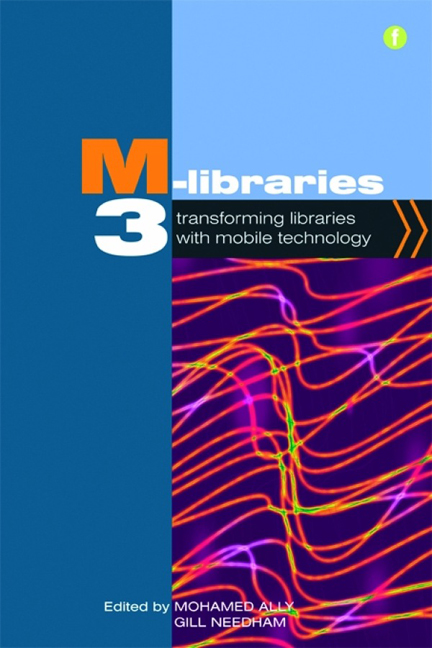Book contents
- Frontmatter
- Contents
- Acknowledgements
- Contributors
- Foreword
- Introduction
- 1 Education for all with mobile technology: the role of libraries
- PART 1 DEVELOPING MOBILE SERVICES
- 2 Preparing for the mobile world: experimenting with changing technologies and applications for library services
- 3 Enhancing open distance learning library services with mobile technologies
- 4 Use of mobile phones in the delivery of consumer health information
- 5 Deploying an e-reader loan service at an online university
- 6 Mobile service providers and library services in a multi-campus library
- 7 Using mobile technology to deliver information in audio format: learning by listening
- 8 Sound selection: podcasts prove positive
- PART 2 PEOPLE AND SKILLS
- PART 3 FOCUS ON TECHNOLOGY
- Conclusion
- Index
3 - Enhancing open distance learning library services with mobile technologies
from PART 1 - DEVELOPING MOBILE SERVICES
Published online by Cambridge University Press: 08 June 2018
- Frontmatter
- Contents
- Acknowledgements
- Contributors
- Foreword
- Introduction
- 1 Education for all with mobile technology: the role of libraries
- PART 1 DEVELOPING MOBILE SERVICES
- 2 Preparing for the mobile world: experimenting with changing technologies and applications for library services
- 3 Enhancing open distance learning library services with mobile technologies
- 4 Use of mobile phones in the delivery of consumer health information
- 5 Deploying an e-reader loan service at an online university
- 6 Mobile service providers and library services in a multi-campus library
- 7 Using mobile technology to deliver information in audio format: learning by listening
- 8 Sound selection: podcasts prove positive
- PART 2 PEOPLE AND SKILLS
- PART 3 FOCUS ON TECHNOLOGY
- Conclusion
- Index
Summary
Introduction
This chapter begins with a brief introduction to the University of South Africa in order to provide the background as to why the m-library development is so important for this institution.
The University of South Africa and its library
The University of South Africa (Unisa) is one of the world's top ten mega universities and the fifth largest ODL (open distance learning) institution. With more than 308,000 students registered already for the first semester of 2011, it is also the largest ODL institution in Africa. The Unisa student profile indicates significant diversity: of the students registered in 2011, 306,074 reside in Africa (including South Africa); 1135 in Europe, 790 in Asia, 359 in Oceania; 440 in South America and North America; and 2358 students are living with a disability (University of South Africa, 2011).
During the last decade Unisa has transformed itself into a truly ODL institution. Previously it conformed to the correspondence model of distance learning, with merely one-way communication to students. Study and library materials were predominantly in the printed medium and delivered by post. Requests to the Library likewise arrived via post or fax and depended on the printed medium.
The University's vision is to become ‘the African University in the service of humanity’ (University of South Africa, 2005). This drive to educate the continent in order to be of global service informs the importance of the ODL model to the realization of that vision. Unisa's ODL policy (University of South Africa, 2008) defines ODL as a multidimensional concept that, in practice, seeks to bridge the time, geograph - ical, economic, social, educational and communication distances between students and the institution, between students and academics, between students and courseware, and between students and peers (University of South Africa, 2008). In support of this definition, the Library endeavours to bridge the distance between students and the Library; to use information technology, and mobile technology in particular, to promote open learning for remote learners; and, in light of its diverse student profile, to ensure equal access to information for all its clients.
The Unisa Library provides an important support service to the University. Its vision is ‘towards the leading ODL Library in Africa’ (Unisa Library, 2011).
- Type
- Chapter
- Information
- M-Libraries 3Transforming libraries with mobile technology, pp. 23 - 32Publisher: FacetPrint publication year: 2012
- 2
- Cited by



